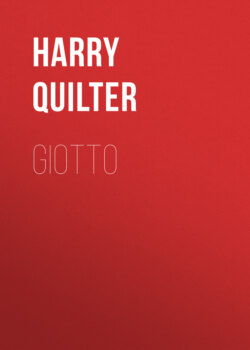Giotto

Реклама. ООО «ЛитРес», ИНН: 7719571260.
Оглавление
Harry Quilter. Giotto
Giotto
Table of Contents
PREFACE
ILLUSTRATIONS
ERRATA
CHAPTER I. INTRODUCTORY
CHAPTER II. ART IN ITALY IN THE THIRTEENTH CENTURY
CHAPTER III. FRESCO PAINTING
CHAPTER IV. CIMABUE
CHAPTER V. GIOTTO
CHAPTER VI. THE CHIEF FUNCTION OF PAINTING
CHAPTER VII. THE EARLY WORK OF GIOTTO AT FLORENCE AND ROME
CHAPTER VIII. GIOTTO AT PADUA
CHAPTER IX. GIOTTO'S STYLE
CHAPTER X. GIOTTO AT ASSISI.—THE UPPER CHURCH
CHAPTER XI. THE LOWER CHURCH OF ASSISI
CHAPTER XII. GIOTTO'S LATER WORK AT FLORENCE
INDEX
Footnote
Отрывок из книги
Harry Quilter
Published by Good Press, 2021
.....
But it surely is not the case that art alone, of all the great influences of the world, reached its apogee in the Middle Ages, and that nothing henceforth remains for it but stagnation or decline. Can we believe that progress will go on in all else, and that art alone is doomed to stand still for ever, like a sort of Lot's wife, looking backward to Venice and Florence, as she to Sodom? Such cannot be the belief of those who hold that progress is not the result of an accidental conjunction of fortunate circumstances, but rather that of an universal law of nature, which ordains that we move for ever forward, though the steps of our advance are rarely perceptible. It is possible that all the older forms of art must die—as they seem to be dying now, of inanition—ere the fuller art be born, but nevertheless the fuller art must come in its season, and whatever be its distinguishing characteristic, this at least is certain, that it will be more in unison with the facts of nature and life, as we now know them, than a reflection of the faded beauties of ancient story. So that we are justified in looking with special interest upon the works of the man who first asserted the principle of the broad relation of art to life, and painted legends of the Madonna, or whatever were his subjects, not in the ancient symbolical manner, but as incidents that happened in the work-a-day world, and were witnessed by spectators, such as might have really existed, some of whom were curious, some scornful, and some indifferent.
Whatever changes art may undergo in the future, our debt will be none the less to those who have made it such as we know it now, to those early workers who struggled against difficulties and solved them for us, and whose imperfections formed the groundwork of our fuller knowledge. And chief of these, as the first who introduced a rational and verifiable manner of painting, is Giotto Bondone, the pupil of Cimabue, who not only cast on one side the arbitrary forms of representation handed down from the Byzantine artists, but, as we have said, introduced into his pictures the element of natural life, and carrying his reform into the very heart of his subject, adopted for his characters not only appropriate action and natural positions, but made the whole picture tell a story of human life, instead of making it a composition of more or less graceful lines and variegated colours.
.....